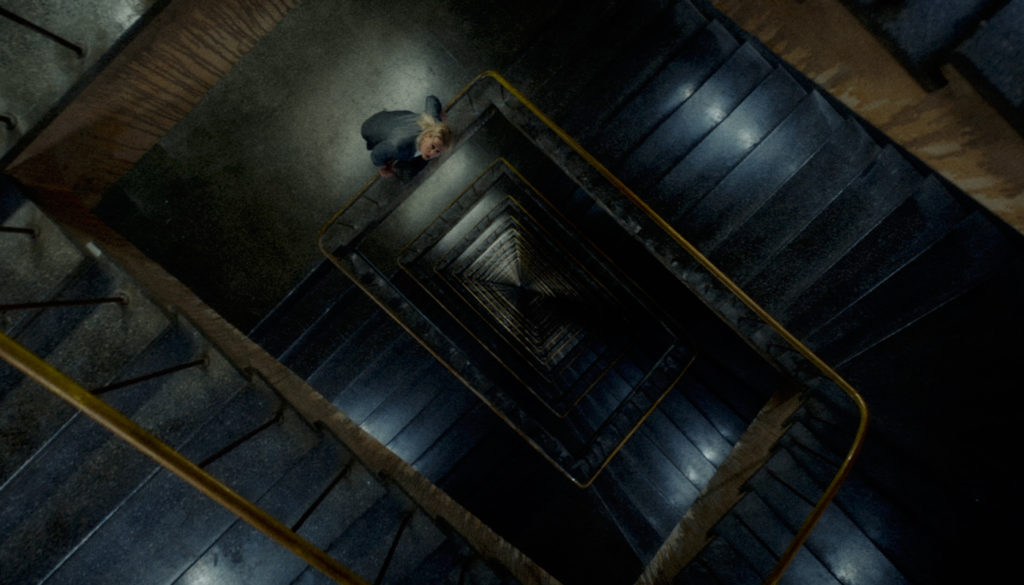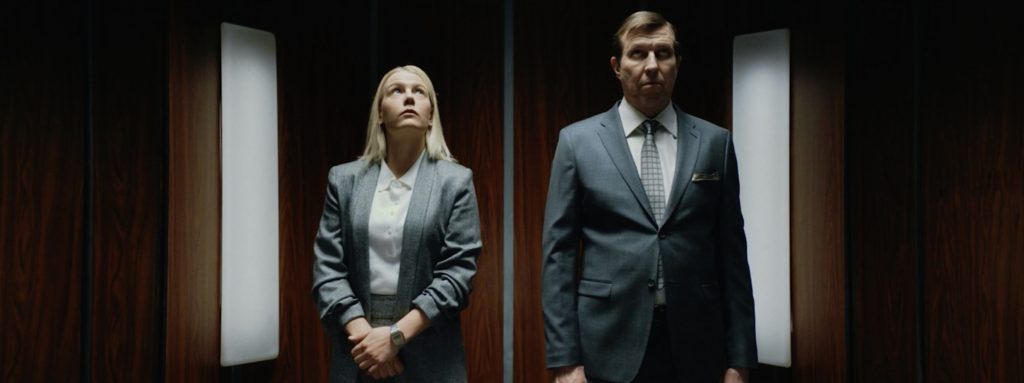Review: Limbo (2019)

There are probably few falser-sounding expressions than “We are all in this together”. The process two random people are in might be the same, but the roles and the positions of a recently fired office worker and the human resources manager who fired him could not be more different. The place might be a broken elevator or an endless brutalist neon-lit staircase as an illustration of the film title that is a metaphor for work and life where different categories gender-, age- and class-wise are pitted against each other.
Nalle Sjöblad’s Limbo had its TV premiere in its native Finland last December and is currently screening in the international shorts program at NIFFF. Its “light horror” style serves its purpose to mask a straight-up social drama that lays in the centre of the plot, making it a possible programming choice for both genre-oriented and “regular” film festivals, but it is still open how much of it would work in either of the contexts.
When an elevator, carrying 50-something Markku (Martti Suosalo), whose name we learn only from the credits, and 30-ish Eeva (Iida Kuningas), breaks down, the duo is forced to take the staircase down and hopefully out of the building. It seems endless, which obviously stresses them, but the real problem is their recent history: he was just fired by her. The quarrel ensues and the slurs are exchanged, so we learn what does it mean to be a “pint-sized chick and a millennial born with a silver spoon in her ass”, or a member of “the pig-boy generation which f*cked everything up”, who is privileged for what reasons, who had to work and why and what is a typical white male behaviour.
Part of the problem with the whole thing is the fact that both of the characters are clearly the archetypes (or even stereotypes) for their gender, age and class, so the whole verbal conflict between the two seems quite artificial, even with the dialogue being laced with typical Finnish cursing and swearing. However, the sentiment rarely feels real, as it is more of a common denominator of what would a member of a certain social type say. The additional trouble is that the actual physical violence comes a tad too late and stands for a too short period of time for an atmosphere of horror to build up, and the usual dramaturgical trick “the rules of physics do not apply any more” does not cut the deal.
Nevertheless, Limbo is far from an inferior cinematic work, for its production and craft values. The elevator music playing in the beginning and in the end is a nice stylistic touch, the cinematography handled by Daniel Lindholm amplifies the claustrophobia of the situation, and Aleksi Raij’s editing is precise. The acting is also quite solid, even though the characters are under-developed, but at least Sjöblad had enough faith in them to let them use their intuition in order to express themselves. All things considered, Limbo is more effective as a social statement than as a piece of genre cinema.

Runtime: 9′ 33”
Country: Finland
Language: Finnish
Directed by: Nalle Sjöblad
Written by: Nalle Sjöblad, Antero Jokinen
Cast: Martti Suosalo, Iida Kuningas
Cinematography by: Daniel Lindholm
Editing by: Aleksi Raij
Music by: Marko Nyberg
Sound design by: Akseli Soini
Costume design by: Kaisa Pohjola
Make-up by: Kaisa Pohjola
Visual effects by: Henri Pulla
Colourist: Henri Pulla
Assistant director: Tuula Nikkola
Produced by: Teemu Nikki, Jani Pösö
Production company: It’s Alive Films
















